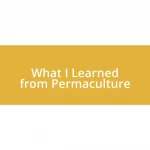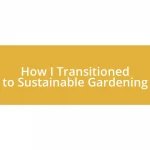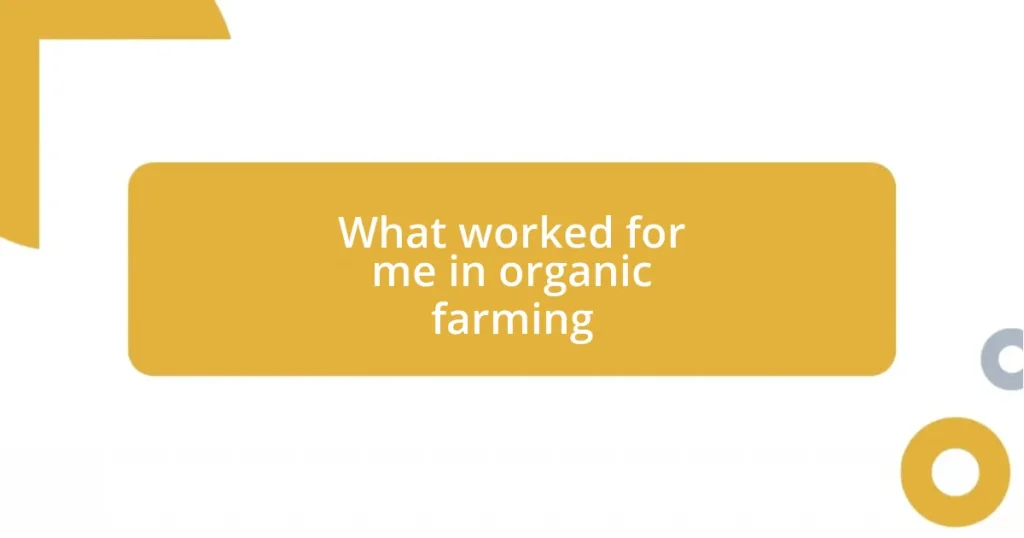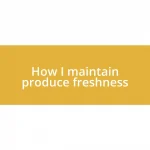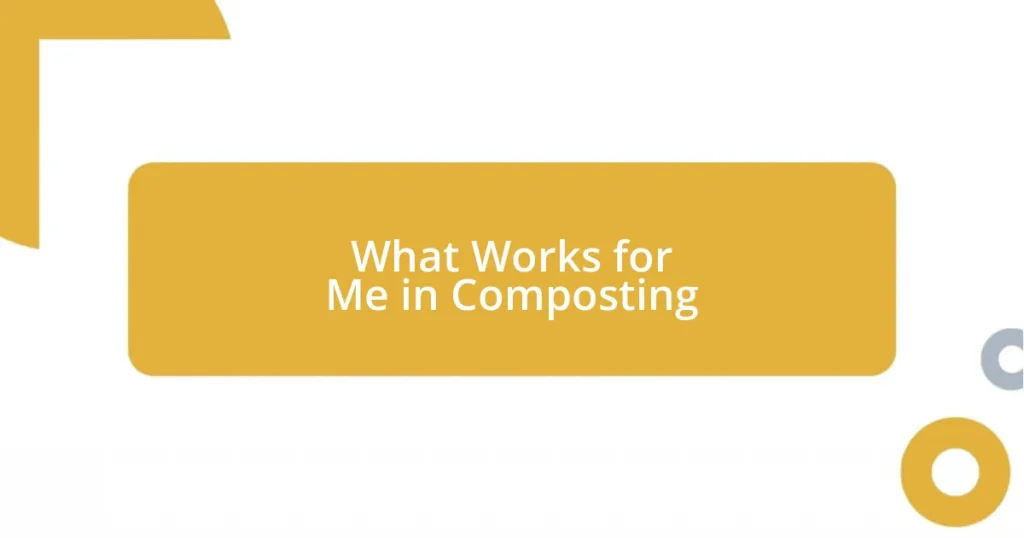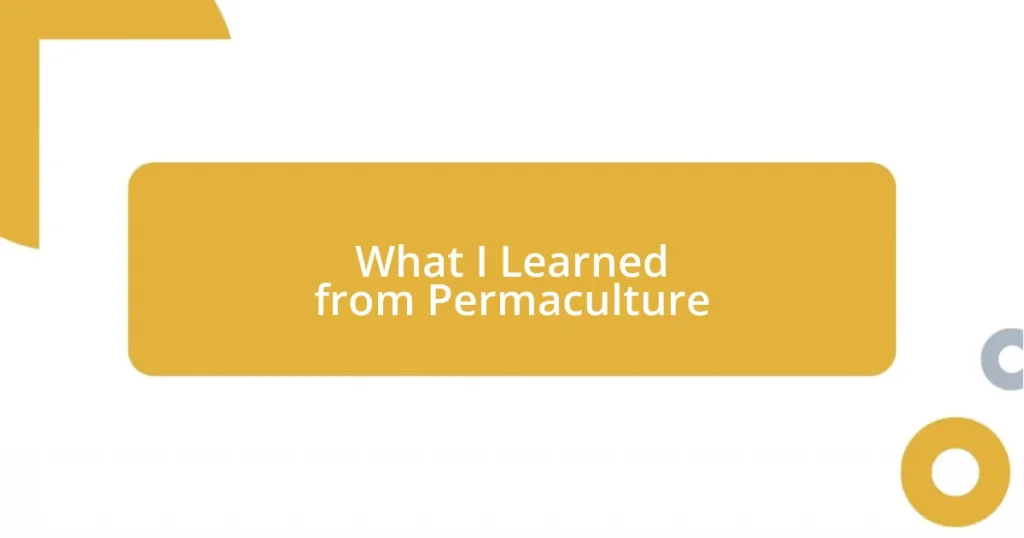Key takeaways:
- Embraced the essence of organic farming through resilience and community engagement, recognizing the interconnectedness of nature.
- Learned the importance of biodiversity, soil health, and natural pest management as foundational principles for successful organic farming.
- Utilized effective soil management techniques, including cover crops and composting, leading to improved soil fertility and crop health.
- Realized the value of sustainable practices like crop rotation and mulching, which enhanced yields and reduced environmental impact.

My journey into organic farming
Starting my journey into organic farming was like stepping into a new world filled with both challenges and excitement. I still remember the first day I tilled the soil; it was a mix of anticipation and sheer awe. Getting my hands dirty and breathing in the earthy scent ignited a passion in me I didn’t know existed. Have you ever felt that rush of hope when you start something fresh? For me, it was the moment I decided to grow not just food, but also a healthier way of life.
As I began experimenting with different crops, I faced my fair share of failures. I distinctly recall a season when my heirloom tomatoes succumbed to blight. It was disheartening, but I learned an invaluable lesson about resilience and the importance of biodiversity. Each setback pushed me to research and adopt better practices, nurturing a deeper connection with the land. Did I ever doubt my decision? Absolutely. But those moments taught me that every struggle is a stepping stone.
What truly transformed my perspective was realizing that organic farming isn’t just about cultivating crops; it’s also about cultivating a sustainable future. I’ve had countless conversations with fellow farmers, where we share not just techniques but our hopes for future generations. Being part of a community striving for healthier ecosystems has been rewarding beyond measure. Have you ever felt that sense of belonging? It’s like finding your tribe, and for me, organic farming became just that.

Essential principles of organic farming
Organic farming hinges on a core set of principles that shape the way we interact with nature. These principles not only guide us in our farming practices but also encourage a deeper respect for the earth. I remember the moment I truly grasped the concept of holistic farming. I was tending to my garden when I noticed how companion planting made a real difference. Planting marigolds alongside my tomatoes wasn’t just a colorful choice; it actually helped keep pests at bay. It was a lightbulb moment for me, realizing that everything is interconnected in this beautiful ecosystem.
Here are some essential principles of organic farming that have profoundly influenced my practice:
- Biodiversity: Embracing a variety of plants and animals promotes resilience in your farming system.
- Soil Health: Focusing on nurturing the soil is vital; healthy soil translates to healthy crops. Composting became a game changer for me.
- Natural Pest Management: Using beneficial insects and organic solutions can effectively control pests without harming the environment.
- Sustainability: Making decisions that meet today’s needs without compromising future generations ensures the longevity of our practices.
- Community Engagement: Cultivating connections with fellow farmers fosters a spirit of shared knowledge and support, enriching our organic farming journey.
By recognizing and applying these principles, I not only improved my yields but also deepened my appreciation for the delicate balance of nature. Each harvest became more than just a product of labor; it transformed into a celebration of this enduring relationship with the earth.

Effective soil management techniques
Effective soil management techniques have been pivotal in my organic farming journey. One practice that has truly resonated with me is the use of cover crops. By planting cover crops during the off-season, I witnessed remarkable improvements in soil structure and fertility. It was a revelation! Not only did these crops prevent erosion, but they also added vital nutrients back into the soil, making my garden more productive and resilient.
I’ve also embraced composting as an essential technique. The transformation of kitchen scraps and yard waste into rich compost felt like magic to me. I remember the first time I dug into my compost pile and uncovered the dark, crumbly treasure. The emotional satisfaction of knowing I was recycling waste into nourishment for my soil was immensely rewarding. Composting has not only enriched my soil but has fostered a deeper connection to the cycles of life on my farm.
Finally, regular soil testing has become a cornerstone of my approach to soil management. Initially, I was hesitant about shelling out for testing, but what I learned transformed my farming game. The first test revealed nutrient deficiencies I hadn’t noticed, prompting me to adjust my fertilization strategy accordingly. Understanding the specific needs of my soil allowed me to cultivate healthier crops. Who knew a simple soil test could spark such profound changes in my farming practices?
| Technique | Benefits |
|---|---|
| Cover Crops | Soil structure improvement, erosion prevention, nutrient replenishment |
| Composting | Waste recycling, enhanced soil fertility, environmental impact reduction |
| Soil Testing | Informed fertilization strategies, tailored nutrient management, improved crop health |

Pest control methods that work
One of the most effective pest control methods I discovered was introducing beneficial insects to my garden. I remember the first time I released ladybugs into my aphid-infested pea plants. It felt like a mini celebration as I watched those little beetles go to work, devouring the pests. The satisfaction of seeing my plants thrive without resorting to harsh chemicals was incredible. Have you ever felt that rush of joy when nature takes care of itself?
Another method that truly resonated with me was using homemade garlic spray. When I first encountered those persistent caterpillars munching on my cabbage, I blended garlic cloves with a bit of water, and voilà! The pungent aroma not only deterred the pests but also left my plants unharmed. It was empowering to realize that an ordinary kitchen ingredient could be such a powerful ally in pest control. Have you ever tried crafting a solution from what you already have? It’s liberating!
Companion planting also became a game changer in my pest control strategy. I clearly recall the year I paired basil with my tomatoes. Not only did it draw in pollinators, but it also significantly reduced tomato hornworm problems. This simple practice made my garden more vibrant and diverse while minimizing pest issues. How amazing is it that the right plant combinations can enhance resilience against pests? Discovering these methods has deepened my appreciation for the harmony in nature, and I invite you to explore these strategies to see what works for you.

Sustainable practices for long-term yield
In my experience, integrating crop rotation into my farming schedule has been a game changer for sustainability and yield. I used to plant the same crops in the same spots year after year, but that approach left me with diminishing results. The first time I switched it up and rotated my tomatoes and peppers with beans, I was amazed at the improved soil health and reduced pest issues. Have you ever thought about how simply changing the location of your crops could boost your harvest?
Additionally, I’ve found that mulching is one of the simplest yet most effective sustainable practices to maintain moisture and suppress weeds. I remember the first summer I applied a thick layer of straw around my vegetable beds. It was like my plants breathed a sigh of relief as they enjoyed a consistent moisture level, and I spent far less time battling stubborn weeds. It made me realize how a natural resource could simplify my life while enhancing my crop’s health. Who wouldn’t want to make their farming tasks easier and more productive?
Lastly, practicing agroforestry has been a revelation for me. Incorporating trees into my farming setup not only provided shade to sensitive crops but also created a microclimate that supported biodiversity. I vividly recall planting a row of fruit trees alongside my vegetable garden. Over the subsequent seasons, not only did I enjoy delicious apples and pears, but the presence of the trees also attracted pollinators and beneficial wildlife. How satisfying is it to see your efforts yield benefits on multiple levels? Embracing these sustainable practices has turned my farm into a thriving ecosystem, and I truly believe there’s something to gain for every farmer willing to experiment.

Lessons learned and mistakes made
One of the hardest lessons I learned was about over-fertilizing my crops. Early on, I was eager to boost my yields, so I applied a generous amount of organic fertilizer without fully understanding its impact. When my plants started showing signs of nutrient burn, I felt a mix of disappointment and frustration. It made me realize that more isn’t always better—sometimes, moderation and patience are key. Have you ever been tempted to go all in, only to discover that it’s not the best approach?
Another mistake I made was neglecting the importance of soil testing. I thought my garden was thriving on intuition alone, but my plants often struggled without the right balance of nutrients. It wasn’t until I got a soil test that I understood why my tomatoes weren’t producing as expected. The moment I adjusted my soil amendments based on those results, it was like a weight had lifted, and I felt a spark of excitement as my garden began to flourish. Have you experienced that “aha” moment that came from paying attention to the fundamentals?
Lastly, I can’t stress enough the value of time management. In my early days, I often overcommitted, trying to tackle too many projects at once. I remember spending countless weekends exhausted from trying to nurture every single seedling while neglecting the foundational tasks like weeding and watering. The stress was overwhelming, and it took a hefty toll on my enjoyment of farming. I learned the hard way that prioritizing key tasks makes all the difference. How do you balance your time in the garden? Finding that sweet spot between ambition and practicality is crucial for anyone aiming to enjoy their organic farming journey.


